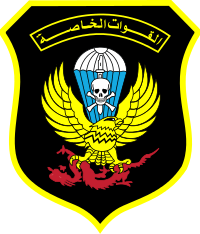Al-Saiqa (Libya)
| Al'Saiqa | |
|---|---|
| Participant in Libyan Civil War and Post-civil war violence in Libya | |
|
Libyan Special Forces Emblem. | |
| Active | 1964 – present |
| Founder | Abdel Fatah Younis |
| Leaders | Wanis Bukhamada |
| Headquarters | Benghazi |
| Area of operations | Benghazi |
| Strength | Up to 5,000 soldiers[1] |
| Allies |
|
| Opponents |
Shura Council of Benghazi Revolutionaries |
| Battles and wars |
Libyan Civil War 2011 2013 Benghazi conflict 2014 Libyan conflict |
The Libyan Special Forces, (Arabic:القوات الخاصة الليبية), less formally known as Al-Saiqa (English: Lightning, Thunderbolt, Arabic:الصاعقة) are an elite Libyan National Army unit, formed from a mixture of paratroopers, paramilitary forces and commandos. (They should not be confused with the similarly named Lightning Bolt Brigade (Sawaiq Brigade) which is part of the Zintan Brigades.)
The pro-Government force emerged from a militia in 2010; however, the Al Saiqa Brigade has been criticised for its origins which track back to the Qaddafi's regime: In 1990s, al-Saiqa helped to suppress the rebellion of Libyan Islamic Fighting Group. It now numbers about 5000 soldiers and reports to the Ministry of Defence.[2]
As of 2013, the Al-Saiqa commander was Colonel Wanes Abu Khamadah.
Benghazi Clashes
Al-Saiqa came to prominence after its deployment in Benghazi in summer 2013, in an attempt to control the growing disorder. As a result, it came under repeated attacks and several of its officers killed. The force is reportedly popular in Benghazi,[3][4] particularly in light of its stance against the Islamist Ansar al-Sharia group and because it is seen as a symbol of the reborn Libyan armed forces.
The Al-Saiqa Brigade reportedly has had frictions with the Libya Shield Force, a government-sanctioned powerful militia;[5] despite these frictions, between November and December 2013 the Al-Saiqa Brigade fought the Ansar al-Sharia militia,[6] suffering some losses.[7]
At the end of July 2014 the Brigade was pushed out of its main base in Benghazi's Buatni district by Islamist fighters from the Shura Council of Benghazi Revolutionaries. A senior Saiqa official later claimed to the Libya Herald that Saiqa losses in Benghazi between the 21 and 30 July totaled some 63 dead and 200 wounded. Whilst the official was unsure of the number of Islamist dead, he claimed that it was in the dozens.[8]
By 13 August the Saiqa presence in Benghazi was almost entirely limited to Benina Airport; the base of Operation Dignity's helicopter unit. Many of the forces top commanders were in turn operating out of the Operation Dignity stronghold of Tobruk.[9]
Related voices
References
- ↑ Finucci, Francesco. "Libya: military actors and militias" (PDF). Global Security. Retrieved 20 March 2014.
- ↑ "Guide to key Libyan militias and other armed groups". BBC. Retrieved 20 March 2014.
- ↑ "Guide to key Libyan militias and other armed groups". BBC. Retrieved 20 March 2014.
- ↑ Algattani, Ali (2013-07-31). "Benghazi faces tough task securing streets". Magharebia. Retrieved 20 March 2014.
- ↑ Algattani, Ali (2013-07-31). "Benghazi faces tough task securing streets". Magharebia. Retrieved 20 March 2014.
- ↑ McGregor, Andrew. "LIBYAN SPECIAL FORCES EXPEL ANSAR AL-SHARI'A FROM BENGHAZI". Aberfoyle International Security. Retrieved 20 March 2014.
- ↑ Burweila, Aya. "Libya, Syria, and the Resurgence of Al-Qaeda". The Jerusalem Review. Retrieved 21 March 2014.
- ↑ Amzein, Aimen (11 August 2014). "Sixty-three Saiqa members killed and 200 wounded in July fighting". Libya Herald. Benghazi. Retrieved 14 August 2014.
- ↑ Ibrahim, Noora (13 August 2014). "Ansar increases presence at Benina check-point as criticism of Saiqa mounts". Libya Herald. Benghazi. Retrieved 14 August 2014.
